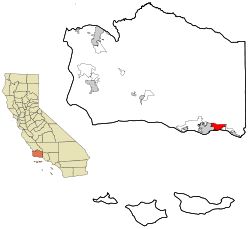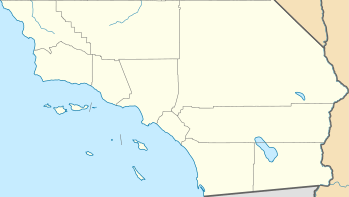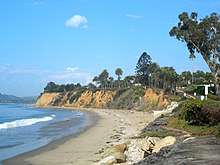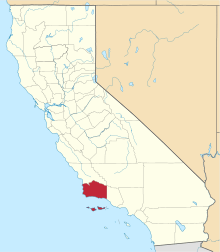Montecito, California
Montecito (Spanish for "little mount") is an unincorporated community and census-designated place in Santa Barbara County, California, located east of the City of Santa Barbara.[5][6] The population was 8,965 at the 2010 census.
Montecito | |
|---|---|
Census designated place | |
.jpg) .jpg)  | |
 Location in Santa Barbara County and the state of California | |
 Montecito Location in the United States  Montecito Montecito (California)  Montecito Montecito (the United States) | |
| Coordinates: 34°26′1″N 119°37′55″W | |
| Country | United States |
| State | California |
| County | Santa Barbara |
| Government | |
| • State senator | Hannah-Beth Jackson (D)[1] |
| • Assemblymember | Monique Limón (D)[1] |
| • U. S. rep. | Salud Carbajal (D)[2] |
| Area | |
| • Total | 9.265 sq mi (23.994 km2) |
| • Land | 9.259 sq mi (23.979 km2) |
| • Water | 0.006 sq mi (0.014 km2) 0.06% |
| Elevation | 180 ft (55 m) |
| Population | |
| • Total | 8,965 |
| • Density | 970/sq mi (370/km2) |
| Time zone | UTC−8 (Pacific) |
| • Summer (DST) | UTC−7 (PDT) |
| ZIP Codes | 93108, 93150 |
| Area code | 805 |
| FIPS code | 06-48844 |
| GNIS feature IDs | 1661052, 2408861 |
Montecito occupies the eastern portion of the coastal plain south of the Santa Ynez Mountains. Parts of the community are built on the lower foothills of the range. Montecito, however, does not include areas such as Coast Village Road, which are usually considered part of Montecito but are actually within the city limits of Santa Barbara. Notable roads spanning Montecito include East Valley Road, Mountain Drive, and Sycamore Canyon Road, all of which form part of State Route 192. In addition, the U.S. 101 Freeway runs along the south end of town, connecting it with other cities in Santa Barbara County and the rest of Southern California.
History
The site of present-day Montecito, along with the entire south coast of Santa Barbara County, was inhabited for over 10,000 years by the Chumash Indians. The Spanish arrived in the 18th century but left the region largely unsettled while they built the Presidio and Mission Santa Barbara farther west.
In the middle of the 19th century, the area was known as a haven for bandits and highway robbers, who hid in the oak groves and canyons, preying on traffic on the coastal route between the towns that developed around the missions. By the end of the 1860s, the bandit gangs were gone, and Italian settlers arrived. Finding an area reminiscent of Italy, they built farms and gardens similar to those they had left behind. Around the end of the 19th century, wealthy tourists from the eastern and midwestern United States began to buy land in the area.[7] It was near enough to Santa Barbara for essential services while still being secluded. Desirable weather and several nearby hot springs offered the promise of comfortable, healthy living, in addition to the availability of affordable land.[8]
The Montecito Hot Springs Hotel was built near the largest of the springs, in a canyon north of the town center and directly south of Montecito Peak, in Hot Springs Canyon. The hotel burned down in 1920; it was replaced a few years later by the smaller Hot Springs Club.[9]
The architect George Washington Smith is noted particularly for his residences around Montecito, and for popularizing the Spanish Colonial Revival style in early 20th century America, as is Lutah Maria Riggs, who started as a draftsman in Smith's firm, rose to partner, and later started her own firm.
Montecito was evacuated five times in four months between December 2017 and March 2018 because of weather-related events, which included the Thomas Fire, the 2018 Southern California mudflows, and flooding related to the Pineapple Express.[10] The mudflows resulted in 20 reported deaths; 28 others were injured, and at least four people[11] were reported missing.[12][13][14][15]
Geography and climate

According to the United States Census Bureau, the CDP has a total area of 9.3 square miles (24 km2), 99.94% of it land and 0.06% of it water.
Montecito experiences a cool Mediterranean climate (Köppen climate classification Csb) characteristic of coastal Southern California. Because of Montecito's proximity to the ocean, onshore breezes significantly moderate temperatures, resulting in warmer winters and cooler summers compared with places further inland. With its gentle Mediterranean climate, Montecito has long been a desirable location for horticulturists. March and April are the months to watch gray whales migrate north from Mexico through the Santa Barbara Channel.[16]
| Climate data for Santa Barbara, California (1981–2010 Normals) | |||||||||||||
|---|---|---|---|---|---|---|---|---|---|---|---|---|---|
| Month | Jan | Feb | Mar | Apr | May | Jun | Jul | Aug | Sep | Oct | Nov | Dec | Year |
| Record high °F (°C) | 89 (32) |
89 (32) |
96 (36) |
101 (38) |
101 (38) |
103 (39) |
108 (42) |
99 (37) |
105 (41) |
103 (39) |
97 (36) |
92 (33) |
108 (42) |
| Average high °F (°C) | 64.7 (18.2) |
65.4 (18.6) |
66.1 (18.9) |
69.0 (20.6) |
69.6 (20.9) |
71.2 (21.8) |
74.7 (23.7) |
76.0 (24.4) |
75.1 (23.9) |
72.8 (22.7) |
68.9 (20.5) |
64.7 (18.2) |
69.9 (21.1) |
| Average low °F (°C) | 46.4 (8.0) |
48.1 (8.9) |
49.8 (9.9) |
51.8 (11.0) |
54.6 (12.6) |
57.5 (14.2) |
60.4 (15.8) |
60.4 (15.8) |
59.6 (15.3) |
56.2 (13.4) |
50.3 (10.2) |
46.7 (8.2) |
53.5 (11.9) |
| Record low °F (°C) | 20 (−7) |
27 (−3) |
30 (−1) |
30 (−1) |
36 (2) |
42 (6) |
44 (7) |
46 (8) |
38 (3) |
34 (1) |
28 (−2) |
25 (−4) |
20 (−7) |
| Average rainfall inches (mm) | 4.14 (105) |
4.68 (119) |
3.59 (91) |
0.77 (20) |
0.35 (8.9) |
0.09 (2.3) |
0.01 (0.25) |
0.03 (0.76) |
0.29 (7.4) |
0.52 (13) |
1.48 (38) |
2.63 (67) |
18.58 (472.61) |
| Average rainy days (≥ 0.01 in) | 6.5 | 6.3 | 6.5 | 2.9 | 1.4 | 0.9 | 0.4 | 0.5 | 1.2 | 1.7 | 3.8 | 4.9 | 37 |
| Source: Western Regional Climate Center[17] | |||||||||||||
Demographics
2010
The 2010 United States Census[18] reported that Montecito had a population of 8,965. The population density was 967.7 people per square mile (373.6/km2). The racial makeup of Montecito was 8,267 (92.2%) White, 55 (0.6%) African American, 38 (0.4%) Native American, 218 (2.4%) Asian, 6 (0.1%) Pacific Islander, 156 (1.7%) from other races, and 225 (2.5%) from two or more races. Hispanic or Latino of any race were 605 persons (6.7%).
The Census reported that 8,033 people (89.6% of the population) lived in households, 932 (10.4%) lived in non-institutionalized group quarters, and none were institutionalized.
Of the 3,432 households, 831 (24.2%) had children under the age of 18 living in them; 1,936 (56.4%) were opposite-sex married couples living together, 234 (6.8%) had a female householder with no husband present, 93 (2.7%) had a male householder with no wife present. There were 110 (3.2%) unmarried opposite-sex partnerships, and 36 (1.0%) same-sex married couples or partnerships. 941 households (27.4%) were made up of individuals and 527 (15.4%) had someone living alone who was 65 years of age or older. The average household size was 2.34. There were 2,263 families (65.9% of all households); the average family size was 2.79.
The age spread of the population accounts 1,515 people (16.9%) under the age of 18, 1,234 people (13.8%) aged 18 to 24, 1,169 people (13.0%) aged 25 to 44, 2,716 people (30.3%) aged 45 to 64, and 2,331 people (26.0%) who were 65 years of age or older. The median age was 50.0 years. For every 100 females, there were 87.3 males. For every 100 females age 18 and over, there were 83.9 males.
4,238 housing units represented an average density of 457.5 per square mile (176.6/km2), of which 2,522 (73.5%) were owner-occupied, and 910 (26.5%) were occupied by renters. The homeowner vacancy rate was 2.4%; the rental vacancy rate was 8.7%. 6,081 people (67.8% of the population) lived in owner-occupied housing units and 1,952 people (21.8%) lived in rental housing units.
2000
The census[19] of 2000 counted 10,000 people, 3,686 households, and 2,454 families residing in the census-designated place (CDP). The population density was 1,072.3 people per square mile (413.8/km2). There were 4,193 housing units at an average density of 449.6 per square mile (173.5/km2). The racial makeup of the CDP was 94.0% White, 0.5% African American, 0.3% Native American, 1.3% Asian, 0.2% Pacific Islander, 2.1% from other races, and 1.5% from two or more races. Hispanic or Latino of any race were 5.2% of the population.
Out of the total of 3,686 households, 25.7% had children under the age of 18 living with them, 57.1% were married couples living together, 7.2% had a female householder with no husband present, and 33.4% were non-families. 27.0% of all households were made up of individuals and 14.0% had someone living alone who was 65 years of age or older. The average household size was 2.41 and the average family size was 2.85.
The CDP population age distribution was 18.4% under the age of 18, 13.5% from 18 to 24, 16.6% from 25 to 44, 30.0% from 45 to 64, and 21.5% who were 65 years of age or older. The median age was 46 years. For every 100 females, there were 84.7 males. For every 100 females age 18 and over, there were 82.1 males.
The median income for a household in the CDP was $110,669, and the median income for a family was $130,123. Males had a median income of $81,719 versus US$42,182 for females. The per capita income for the CDP was $70,077. About 2.3% of families and 3.8% of the population were below the poverty line, including 2.6% of those under age 18 and 2.2% of those age 65 or over.
Government and public safety
As an unincorporated area of Santa Barbara County, Montecito has no city government.[20] Its residents must rely on the county government for all municipal services.[20] Instead of voting for a city council, all of Montecito's residents are represented by only one of the five seats on the county board of supervisors.[20] Unlike other unincorporated areas in the county, Montecito does have two government agencies which together act as its planning commission: the Montecito Board of Architectural Review and the Montecito Planning Commission.[20] Municipal incorporation is a perennially recurring issue in local politics, but has never come to fruition.[20]
Like other unincorporated areas, Montecito's law enforcement agency is the Santa Barbara County Sheriff's Office.[21]
Education
Children in Montecito are enrolled at Montecito Union Elementary and Cold Spring Elementary School.[22]
Notable architecture
- Lotusland – design and botanic gardens
- El Fureidis – designed by Bertram Grosvenor Goodhue
- Music Academy of the West
- Casa del Herrero – Spanish Colonial revival home and gardens
- Coral Casino Beach and Cabana Club at the Santa Barbara Biltmore – designed by Gardner A. Dailey; designated as a historical landmark in 2003
- Montecito Inn – built by Charlie Chaplin
- Santa Barbara Vedanta Temple – designed by Lutah Maria Riggs
Notable people
- Douglas Adams
- Troy Aikman
- Dame Judith Anderson
- Ross Bagdasarian, Jr. & Janice Karman
- William Baldwin
- Thomas J. Barrack, Jr.
- Drew Barrymore (2010–2013)[23]
- Jason Bateman
- T. C. Boyle
- Jeff Bridges
- Mike Bryan
- Carol Burnett
- Elizabeth Eaton Burton
- Frank Caufield
- Julia Child
- John Cleese
- Jimmy Connors
- Fred Couples
- Christopher Cross
- Tom Cruise
- Elizabeth Daily
- Portia de Rossi
- Ellen DeGeneres
- Bradford Dillman
- Kirk Douglas
- Michael Douglas
- Anne Francis
- Tom Freston
- Bob Gale
- Prince Harry, Duke of Sussex
- Meghan, Duchess of Sussex
- Olivier Leclercq[24]
- Martin Lee Gore
- Tipper Gore[25]
- Sue Grafton
- Andy Granatelli
- Gene Hackman
- Pamela Hensley
- Paul Hogan
- Tab Hunter
- Kathy Ireland
- Burl Ives
- Bruce Johnston
- Christopher Lloyd
- Kenny Loggins
- Julia Louis-Dreyfus
- Rob Lowe
- David Manners[26]
- Steve Martin
- Dennis Miller
- Robert Mitchum
- Charlie Munger
- Paul Muni
- Peter Noone
- Brad Paisley[27]
- Jack Palance
- Suzy Parker
- Zack Pearlman
- Chynna Phillips
- Robert Preston
- Ivan Reitman
- Eva Marie Saint
- John Sanford
- Lori Saunders
- Eric Schmidt
- Ed Snider
- Peter Sperling
- Timothy Stack
- Thomas Steinbeck
- Shaun Tomson
- John Travolta
- E. Duke Vincent
- Joe Walsh
- Ganna Walska
- Ty Warner
- Stuart Whitman
- Bruce Willis
- Owen Wilson
- Oprah Winfrey[28][29]
Notes
- "Statewide Database". UC Regents. Archived from the original on February 1, 2015. Retrieved November 7, 2014.
- "California's 24th Congressional District - Representatives & District Map". Civic Impulse, LLC. Retrieved September 29, 2014.
- "2010 Census U.S. Gazetteer Files – Places – California". United States Census Bureau.
- "Montecito". Geographic Names Information System. United States Geological Survey. Retrieved November 7, 2014.
- Panzar, Javier (December 12, 2017). "Ornamental landscaping in celebrity-studded Montecito adds to fire danger". LA Times. Retrieved December 13, 2017.
- McCormack, Don (1999). McCormack's Guides Santa Barbara and Ventura 2000. Mccormacks Guides. p. 58. ISBN 9781929365098.
- Covarrubias, Amanda (January 19, 2015) "Montecito poised to decide on a modern version of Miramar Hotel" Los Angeles Times
- Baker, p. 61-62
- Baker, p. 62
- Molteni, Megan (March 23, 2018). "See Everything Bad About Climate Change in a Single California Town". WIRED. Retrieved March 24, 2018.
- "Here are all the people who died in the California mudslide". USA TODAY. January 14, 2018.
- http://www.ksby.com/story/37252693/five-people-now-missing-17-killed-in-montecito-mudslides
- https://www.nbcnews.com/news/us-news/california-mudslide-officials-scramble-clear-debris-another-storm-hits-n837591
- "13 dead in Southern California as rain triggers mudslides". San Francisco Chronicle. January 9, 2018. Retrieved January 10, 2018.
- Mejia, Brittny; Hamilton, Matt; Etehad, Melissa; Tchekmedyian, Alene (January 11, 2018). "Up to 43 people still missing in Montecito; dead include four children". The Los Angeles Times. Retrieved January 11, 2018.
- Robert Reinhold (March 17, 1991), What's Doing In: Santa Barbara New York Times.
- http://www.wrcc.dri.edu/cgi-bin/cliMAIN.pl?ca7902
- "2010 Census Interactive Population Search: CA – Montecito CDP". U.S. Census Bureau. Archived from the original on July 15, 2014. Retrieved July 12, 2014.
- "U.S. Census website". United States Census Bureau. Retrieved 2008-01-31.
- Meagher, Chris (3 July 2008). "Montecity? The Pros and Cons of Incorporation". Santa Barbara Independent. Retrieved 14 August 2020.
- McCormack, Don (1999). McCormack's Guides Santa Barbara and Ventura 2000. Mccormacks Guides. p. 59. ISBN 9781929365098.
- McCormack, Don (1999). McCormack's Guides Santa Barbara and Ventura 2000. Mccormacks Guides. p. 58. ISBN 9781929365098.
- Beale, Lauren (November 17, 2013). "Actress Drew Barrymore sells Montecito estate for $6.35 million". The Los Angeles Times. Retrieved July 16, 2017.
- Olivier and family owns and manage the largest sport retailler in the world. OXYLANE group employs 60 000 in 20 countries except US. www.oxylane.com/En and fr:Oxylane
- Staff writers (April 30, 2010). "Orange Punch: Al Gore's massive carbon footprint". The Orange County Register. Retrieved 25 September 2010.
- his relative & my friend Brandon Chase is his grand nephew and told us about his movies and retirement to Montecito, Calif.
- Michelle Drown (May 10, 2018). "Brad Paisley's Montecito Mission". The Santa Barbara Independent.
- Flemming, Jack (2019-11-13). "Oprah buys Jeff Bridges' Montecito ranch for $6.85 million". Los Angeles Times. Retrieved 2019-11-14.
- David, Mark (February 8, 2016). "Oprah Coughs Up Almost $29 Million for Equestrian Estate in Montecito". Variety. Retrieved July 16, 2017.
References
- Baker, Gayle. Santa Barbara. Harbor Town Histories, Santa Barbara. 2003. ISBN 0-9710984-1-7.
External links
| Wikimedia Commons has media related to Montecito, California. |
| Wikivoyage has a travel guide for Montecito. |
